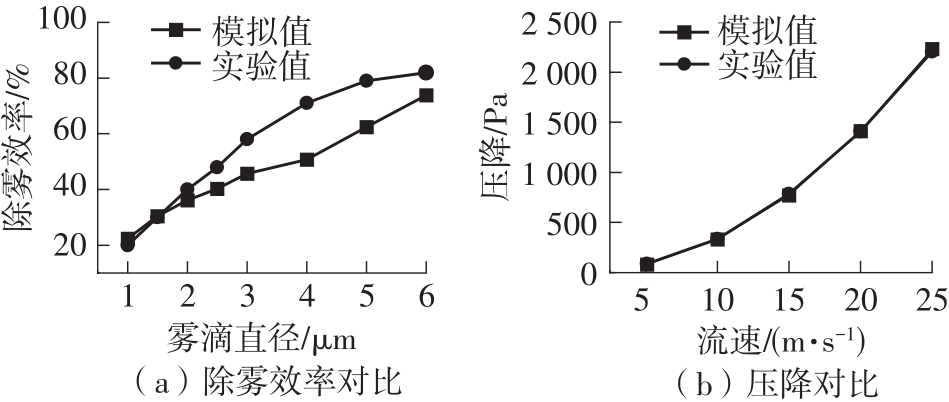| 1 |
华雯,吕瑞亮 .湿法烟气脱硫技术应用现状及发展方向[J].无机盐工业,2022,54(12):1-22.
|
|
HUA Wen, Ruiliang LÜ .Application status and development direction of wet flue gas desulfurization technology[J].Inorganic Chemicals Industry,2022,54(12):1-22.
|
| 2 |
郑寅飞 .湿法烟气脱硫除雾器的应用研究及展望[J].科技展望,2016,26(1):121-122.
|
|
ZHENG Yinfei .Application research and prospect of wet flue gas desulfurization demister[J].Science and Technology,2016,26(1):121-122.
|
| 3 |
刘定平,张宇骏 .基于二次携带现象的折流板除雾性能仿真优化[J].华南理工大学学报(自然科学版),2021,49(10):133-140,150.
|
|
LIU Dingping, ZHANG Yujun .Simulation optimization for performance of wave-plate demister based on re-entrainment[J].Journal of South China University of Technology(Natural Science Edition),2021,49(10):133-140,150.
|
| 4 |
王文燕,袁竹林,黄亚继,等 .提高折流板除雾器对细雾滴脱除性能的研究[J].热能动力工程,2018,33(11):87-92.
|
|
WANG Wenyan, YUAN Zhulin, HUANG Yaji,et al .Research on improving the efficiency of the baffle mist eliminator to remove fine droplets[J].Journal of Engineering for Thermal Energy and Power,2018,33(11):87-92.
|
| 5 |
LIU Yilin, YU Dunxi, JIANG Jingkai,et al .Experimental and numerical evaluation of the performance of a novel compound demister[J].Desalination,2017,409:115-127.
|
| 6 |
XU Y C, YANG Z N, ZHANG J S .Study on performance of wave-plate mist eliminator with porous foam layer as enhanced structure.part I:numerical simulation[J].Chemical Engineering Science,2017,171:650-661.
|
| 7 |
XU Y C, YANG Z N, ZHANG J S .Study on performance of wave-plate mist eliminator with porous foam layer as enhanced structure.part Ⅱ:experiments[J].Chemical Engineering Science,2017,171:662-671.
|
| 8 |
洪文鹏,雷鉴琦 .加装钩片对除雾器性能影响的数值研究[J].动力工程学报,2016,36(1):59-64.
|
|
HONG Wenpeng, LEI Jianqi .Numerical study on performance of serrated baffles with hooks[J].Journal of Chinese Society of Power Engineering,2016,36(1):59-64.
|
| 9 |
FANG C, ZOU R J, LUO G Q,et al .CFD simulation design and optimization of a novel zigz-ag wave-plate mist eliminator with perforated plate[J].Applied Thermal Engineering,2021,184:116112/1-12.
|
| 10 |
VENKATESAN G, KULASEKHARAN N, INIYAN S .Numerical analysis of curved vane demisters in estimating water droplet separation efficiency[J].Desalination,2014,339:40-53.
|
| 11 |
ZHAO J Z, JIN B S, ZHONG Z P . Study of the separation efficiency of a demister vane with response surface methodology[J].Journal of Hazardous Materials,2007,147(1/2):363-369.
|
| 12 |
RAFEE R, RAHIMZADEH H, AHMADI G .Numerical simulations of airflow and droplet transport in a wave-plate mist eliminator[J].Chemical Engineering Reasearch and Design,2010.88(10A):1393-1404.
|
| 13 |
刘定平,鲁文渊 .新型螺旋管式除雾器数值模拟研究[J].华中科技大学学报(自然科学版),2022,51(7):1-9.
|
|
LIU Dingping, LU Wenyuan .Numerical simulation of a new spiral tube mist eliminator[J].Journal of Huazhong University of Science and Technology(Natural Science Edition),2022,51(7):1-9.
|
| 14 |
GUAN L, YUAN Z L, YANG L J,et al .Numerical study on the penetration of droplets in a zig-zag demister[J].Environmental Engineering Science,2016,33(1):35-43.
|
| 15 |
刘定平,黄俊钦,秦方博,等 .基于正交设计的微细颗粒复合凝并建模及仿真[J].华南理工大学学报(自然科学版),2019,47(9):40-46,97.
|
|
LIU Dingping, HUANG Junqin, QIN Fangbo,et al .Modeling and simulation of fine particle composite coagulation based on orthogonal design[J].Journal ofSouth China University of Technology(Natural Science Edition),2019,47(9):40-46,97.
|
| 16 |
刘定平,罗伟乐 .种子颗粒联合声波凝并微细颗粒的研究[J].华南理工大学学报(自然科学版),2017,45(6):131-138.
|
|
LIU Ding-ping, LUO Wei-le .Investigation into coagula-tion of fine particles by combination of seed particles with acoustic wave[J].Journal of South China Uni-versity of Technology(Natural Science Edition),2017,45(6):131-138.
|
| 17 |
刘定平,罗伟乐 .基于旋流与声波的颗粒复合凝并建模与运动轨迹仿真[J].动力工程学报,2017,37(5):413-417.
|
|
LIU Dingping, LUO Weile .Moving trajectory simulation of particles and modeling of the complex coagulation based on swirl and acoustic wave[J].Journal of Chinese Society of Power Engineering,2017,37(5):413-417.
|
| 18 |
陈建孟,谭天恩,史小农 .旋流塔板上的气流运动[J].高校化学工程学报,1993,7(3):235-241.
|
|
CHEN Jianmeng, TAN Tian’en, SHI Xiaonong .Gas flow field above rotating stream tray[J].Journal of Chemical Engineering of Chinese Universities,1993,7(3):235- 241.
|
| 19 |
陈建孟,陈洪波,谭天恩 .旋流塔板上气体流场的数值模拟[J].浙江工学院学报,1994,63(2):17-22.
|
|
CHEN Jianmeng, CHEN Hongbo, TAN Tian’en .Numerical simulation of gas flow field on rotating stream tray[J].Journal of Zhejiang University of Technology,1994,63(2):17-22.
|
| 20 |
陈建孟,柴骏 .旋流塔板上液滴的粒径分布和运动模型[J].浙江工业大学学报,1996,24(2):131-137.
|
|
CHEN Jianmeng, CHAI Jun .Size distributions and model of droplets motion on rotating stream tray[J].Journal of Zhejiang University of Technology,1996,24(2):131-137.
|
| 21 |
孙文寿,王高升 .旋流板分离器的结构对三维流场的影响[J].化工学报,2006,57(6):1334-1338.
|
|
SUN Wenshou, WANG Gaosheng .Effects of structure of rotating-streamtray separator on its three-dimensional flowfield[J].Journal of Chemical Industry and Engineering(China),2006,57(6):1334-1338.
|
| 22 |
吴振松,刘国荣,韩拉让 .旋流板分离器分离性能实验研究[J].过滤与分离,2008,18(3):18-20.
|
|
WU Zhensong, LIU Guorong, HAN Larang .Experimental study on separating property of the cyclone separator[J].Journal of Filtration and Separation,2008,18(3):18-20.
|
| 23 |
温斌,旋流板除雾器的流场模拟与提效研究[D].北京:中国石油大学(北京),2017 .
|
| 24 |
LIU Yilin, YU Dunxi, JIANG Jingkai,et al .Experi-mental and numerical evaluation of the performance of a novel compound demister[J].Desalination,2017,409:115-127.
|
| 25 |
VENKATESAN G, KULASEKHARAN N, INIYAN S .Design and selection of curved vane demisters us-ing Taguchi based CFD analysis[J].Desalination,2014,354:39-52.
|
| 26 |
徐淑君,姚征,朱懿渊 .波纹板除雾器两相流动的数值模拟与分析[J].上海理工大学学报,2007,29(3):275-280.
|
|
XU Shujun, YAO Zheng, ZHU Yiyuan .Numerical simulation on two phase flow in demister with corrugated baffle[J].Journal of University of Shanghai for Science and Technology,2007,29(3):275-280.
|
| 27 |
WANG Y, JAMES P W .The calculation of wave-plate demister efficiencies using numerical simulation of the flow field and droplet motion[J].Chemical Engineering Research and Design,1998,76(8):980-985.
|
| 28 |
沈俊杰,童小忠,乔宗良,等 .折流板除雾器内液滴运动和分离特性的数值研究[J].热能动力工程,2020,35(3):173-180.
|
|
SHEN Junjie, TONG Xiaozhong, QIAO Zongliang,et al .Numerical study on droplet movement and separation characteristics in baffle plate demister[J].Journal of Engineering for Thermal Energy and Power,2020,35(3):173-180.
|
| 29 |
DIRGO J, LEITH D .Cyclone collection efficiency:comparison of experimental results with theoretical predictions[J].Aerosol Science and Technology,1985,4(4):401-415.
|











